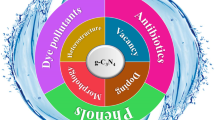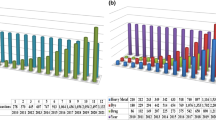Abstract
Photocatalytic hydrogen evolution is considered as one of the promising pathways to settle the energy crises and environmental issues by utilizing solar energy. In this paper, noble-metal-free Ni2P was used as cocatalyst to enhance g-C3N4 for photocatalytic hydrogen production under visible light irradiation (λ > 420 nm). Characterization results indicated that Ni2P nanoparticles were successfully loaded onto g-C3N4, which can significantly contribute to accelerate the separation and transfer of photogenerated electron. The hydrogen evolution rate reached ∼ 270 µmol h−1 g−1 and the apparent quantum yield (AQY) was ∼ 2.85% at 420 nm. Meanwhile, there is no obviously decrease of the hydrogen production rate even after 36 h under visible light illumination. In addition, the mechanism of photocatalytic hydrogen evolution was also elaborated in detail.
Graphical Abstract









Similar content being viewed by others
References
Chen X, Shen S, Guo L et al (2010) Semiconductor-based photocatalytic hydrogen generation. Chem Rev 110(11):6503–6570
Hou Y, Wen Z, Cui S et al (2013) Constructing 2D porous graphitic C3N4 nanosheets/nitrogen-doped graphene/layered MoS2 ternary nanojunction with enhanced photoelectrochemical activity. Adv Mater 25(43):6291–6297
Cheng J, Wang C, Cui Y et al (2014) Large improvement of visible-light-driven photocatalytic property in AgCl nanoparticles modified black BiOCl microsphere. Mater Lett 127:28–31
Walter MG, Warren EL, McKone JR et al (2010) Solar water splitting cells. Chem Rev 110(11):6446–6473
Yin Y, Guo X, Peng D (2018) Iron and manganese oxides modified maize straw to remove tylosin from aqueous solutions. Chemosphere 205:156–165
Dong H, Guo X, Yang C et al (2018) Synthesis of g-C3N4 by different precursors under burning explosion effect and its photocatalytic degradation for tylosin. Appl Catal B 230:65–76
Fujishima A, Honda K (1972) Electrochemical photolysis of water at a semiconductor electrode. Nature 238:37–38
Zhao Y, Jia X, Chen G et al (2016) Ultrafine NiO nanosheets stabilized by TiO2 from monolayer NiTi-LDH precursors: an active water oxidation electrocatalyst. J Am Chem Soc 138(20):6517–6524
Zhang J, Hu Y, Jiang X et al (2014) Design of a direct Z-scheme photocatalyst: preparation and characterization of Bi2O3/g-C3N4 with high visible light activity. J Hazard Mater 280:713–722
Ye L, Deng K, Xu F et al (2012) Increasing visible-light absorption for photocatalysis with black BiOCl. Phys Chem Chem Phys 14(1):82–85
Zhou P, Yu JG, Jaroniec M. All-Solid-State (2014) Z-scheme photocatalytic systems. Adv Mater 26(29):4920–4935
Wang X, Maeda K, Thomas A et al (2009) A metal-free polymeric photocatalyst for hydrogen production from water under visible light. Nat Mater 8(1):76–80
Ong WJ, Tan LL, Ng YH et al (2016) Graphitic carbon nitride (g-C3N4)-based photocatalysts for artificial photosynthesis and environmental remediation: are we a step closer to achieving sustainability? Chem Rev 116(12):7159–7329
Chen BC, Shen Y, Wei JH et al (2016) Research progress on g-C3N4-based Z-scheme photocatalytic system. Acta Phys Chim Sin 32(6):1371–1382
Xue J, Ma S, Zhou Y et al (2015) Facile photochemical synthesis of Au/Pt/g-C3N4 with plasmon-enhanced photocatalytic activity for antibiotic degradation. ACS Appl Mater Interfaces 7(18):9630–9637
Yang XF, Chen ZP, Xu JS et al (2015) Tuning the morphology of g-C3N4 for improvement of Z-scheme photocatalytic water oxidation. ACS Appl Mater Interfaces 7(28):15285–15293
Yang LQ, Huang JF, Shi L et al (2017) A surface modification resultant thermally oxidized porous g-C3N4 with enhanced photocatalytic hydrogen production. Appl Catal B 204:335–345
Liang Q, Li Z, Huang ZH et al (2015) Holey graphitic carbon nitride nanosheets with carbon vacancies for highly improved photocatalytic hydrogen production. Adv Funct Mater 25(44):6885–6892
Su F, Mathew SC, Lipner G et al (2010) mpg-C3N4-catalyzed selective oxidation of alcohols using O2 and visible light. J Am Chem Soc 132(46):16299–16301
Jiang R, Li B, Fang C et al (2014) Metal/semiconductor hybrid nanostructures for plasmon-enhanced applications. Adv Mater 26(31):5274–5309
Liu J, Xu H, Xu Y et al (2017) Graphene quantum dots modified mesoporous graphite carbon nitride with significant enhancement of photocatalytic activity. Appl Catal B 207:429–437
Cheng F, Wang H, Dong X (2015) The amphoteric properties of g-C3N4 nanosheets and fabrication of their relevant heterostructure photocatalysts by an electrostatic re-assembly route. Chem Commun 51(33):7176–7179
Di J, Xia J, Yin S et al (2014) Preparation of sphere-like g-C3N4/BiOI photocatalysts via a reactable ionic liquid for visible-light-driven photocatalytic degradation of pollutants. J Mater Chem A 2(15):5340–5351
Bai S, Yin WJ, Wang LL et al (2016) Surface and interface design in cocatalysts for photocatalytic water splitting and CO2 reduction. RSC Adv 6(62):7446–7463
Ma S, Deng Y, Xie J et al (2018) Noble-metal-free Ni3C cocatalysts decorated CdS nanosheets for high-efficiency visible-light-driven photocatalytic H2 evolution. Appl Catal B 227:218–228
Sun Z, Zheng H, Li J et al (2015) Extraordinarily efficient photocatalytic hydrogen evolution in water using semiconductor nanorods integrated with crystalline Ni2P cocatalysts. Energy Environ Sci 8(9):2668–2676
Sun Z, Yue Q, Li J et al (2015) Copper phosphide modified cadmium sulfide nanorods as a novel p-n heterojunction for highly efficient visible-light-driven hydrogen production in water. J Mater Chem A 3(19):10243–10247
Sun Z, Lv B, Li J et al (2016) Core-shell amorphous cobalt phosphide/cadmium sulfide semiconductor nanorods for exceptional photocatalytic hydrogen production under visible light. J Mater Chem A 4(5):1598–1602
Yue Q, Wan Y, Sun Z et al (2015) MoP is a novel, noble-metal-free cocatalyst for enhanced photocatalytic hydrogen production from water under visible light. J Mater Chem A 3(33):16941–16947
Sun Z, Chen H, Huang Q et al (2015) Enhanced photocatalytic hydrogen production in water under visible light using noble metal-free ferrous phosphide as an active cocatalyst. Catal Sci Technol 5(11):4964–4967
Du P, Eisenberg R (2012) Catalysts made of earth-abundant elements (Co, Ni, Fe) for water splitting: recent progress and future challenges. Energy Environ Sci 5(3):6012–6021
She X, Wu J, Xu H et al (2017) High efficiency photocatalytic water splitting using 2D α-Fe2O3/g-C3N4 Z-scheme catalysts. Adv Energy Mater 7(17):1700025
Che W, Cheng W, Yao T et al (2017) Fast photoelectron transfer in (cring)-C3N4 plane heterostructural nanosheets for overall water splitting. J Am Chem Soc 139(8):3021–3026
Xu J, Wang ZP, Zhu YF (2017) Enhanced visible-light-driven photocatalytic disinfection performance and organic pollutant degradation activity of porous g-C3N4 nanosheets. ACS Appl Mater Interfaces 9(33):27727–27735
Lin Y, Pan Y, Zhang J (2017) In-situ grown of Ni2P nanoparticles on 2D black phosphorus as a novel hybrid catalyst for hydrogen evolution. Int J Hydrogen Energy 42(12):7951–7956
Wang X, Kolen’ko YV, Liu L (2015) Direct solvothermal phosphorization of nickel foam to fabricate integrated Ni2P-nanorods/Ni electrodes for efficient electrocatalytic hydrogen evolution. Chem Commun 51(31):6738–6741
Ye P, Liu X, Iocozzia J et al (2017) A highly stable non-noble metal Ni2P co-catalyst for increased H2 generation by g-C3N4 under visible light irradiation. J Mater Chem A 5(18):8493–8498
Xiao J, Xie Y, Nawaz F et al (2016) Dramatic coupling of visible light with ozone on honeycomb-like porous g-C3N4 towards superior oxidation of water pollutants. Appl Catal B 183(Supplement C):417–425
Lin L, Ou H, Zhang Y et al (2016) Tri-s-triazine-based crystalline graphitic carbon nitrides for highly efficient hydrogen evolution photocatalysis. ACS Catal 6(6):3921–3931
Acknowledgements
This work was funded by the NSFC (21473170), the Fundamental Research Funds for the Central Universities (WK3430000001, WK2060140015, and WK2060190026), Natural science Fund of of Anhui province (1808085ME139), and The Thousand Young Talents Program.
Author information
Authors and Affiliations
Corresponding authors
Ethics declarations
Conflict of interest
The authors declare no competing financial interest.
Rights and permissions
About this article
Cite this article
Ge, J., Jiang, D., Zhang, L. et al. Embedding Noble-Metal-Free Ni2P Cocatalyst on g-C3N4 for Enhanced Photocatalytic H2 Evolution in Water Under Visible Light. Catal Lett 148, 3741–3749 (2018). https://doi.org/10.1007/s10562-018-2562-6
Received:
Accepted:
Published:
Issue Date:
DOI: https://doi.org/10.1007/s10562-018-2562-6




